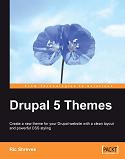|
What is PHPTemplate?
PHPTemplate is one of a family of applications known as templating engines
(referred to frequently in Drupal—and in this text—as "theme engines"). These
applications serve a middleware function and determine the coding syntax, which
will be used to create the theme. As the name implies, PHPTemplate supports the
popular PHP programming language for theme creation.
PHPTemplate was built by developer Adrian Rossouw, and was created specifi cally
for use with Drupal. PHPTemplate is the most widely supported theme engine for
Drupal and is compatible with Drupal 4.6 and up. PHPTemplate is included in the
default distro of the Drupal 5 series.
|

By Ric Shreves
|
This excerpt from Chapter No. 3 "Working with Theme Engines" of
Drupal 5 Themes by Ric Shreves, is printed with
permission from Packt Publishing,
Copyright 2007.
|
Your default PHPTemplate engine fi les are located on your server in the
directory themes/engines/phptemplate; additional theme fi les will appear in
the theme directory of each individual PHPTemplate-enabled theme.
How does it Work?
PHPTemplate is a tool that helps separate the tasks of the programmer from the
tasks of the designer. As a tool, PHPTemplate makes it possible for web
programmers to work on the business logic of an installation without having to
worry too much about the presentation of the content. In contrast, web
designers can focus entirely on the styling of discreet blocks of content and
items, comprising the layout and the interface. Developers and designers can
divide their tasks and optimize their work.
|
Building themes with a theme engine represents a more manageable way of
handling dynamic web applications. Every PHPTemplate theme fi le contains an
HTML skeleton with some simple PHP statements for the dynamic data. The theme
fi les are linked together with the CSS fi les, allowing the dynamic data to be
styled and formatted with ease. In other words, PHPTemplate takes one big step
towards the oft-heard holy grail of separating the presentation from the
content.
The logic included in a PHPTemplate fi le is generally rather basic, relying
primarily on the use of if statements and includes. Much of the code you will
see is even more basic and relates purely to the formatting—CSS styling and
basic HTML.
The fi les contained in the PHPTemplate directory on the server (themes/engines/
phptemplate) work in conjunction with the fi les located in the active theme's
directory (principally the page.tpl.php file) to produce the resulting output.
The page.tpl.php fi le is the only PHPTemplate fi le required to enable a theme
to employ the theming engine; likewise, all PHPTemplate themes will have this
fi le inside the theme's directory.
Template files are written in PHP and contain a series of includes and
conditional statements designed to detect the presence of elements that must be
added into the fi nal output. The includes and conditional statements relate to
things like the content of the site title, the presence and location of a logo
fi le, the number of active regions, boxes, etc. Whether a statement is satisfi
ed, and the content displayed, is often the product of decisions made by the
site administrator in the process of confi guring the site as well as decisions
made during the creation of content and functionality.
|